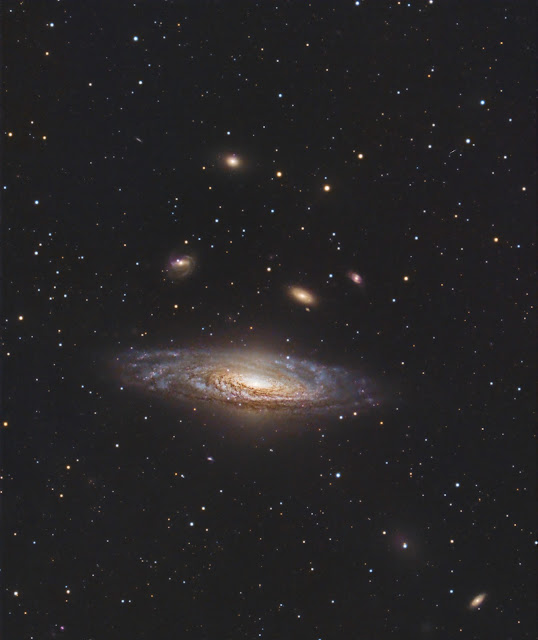The last in a recent string of clear nights ... but 1st a quick story:
A few years back my family was driving home from a family event on beautiful clear night. Someone remarked how beautiful the stars looked and my mother-in-law said, "oh yes, and you can really see the little Dipper!". I'm driving and trying to contain my inner Sheldon Cooper, we are driving south, there is no way she's talking about the Little Dipper. When we got home and parked the car, I asked her to show me. She pointed directly to the Pleiades. I realized it does in fact look like a min dipper. I politely explained what she was actually looking at and showed her how to find the actual Little Dipper. She was un-impressed. I don't think I ever consciously realized that M45 looks like a mini-dipper before (even though I have observed it for years). Now I often describe it in this way when describing it. Now back to your regularly scheduled blog post.
From Saturday 2/3/2024 through Tuesday 2/6/2024, we had a string of 4 clear nights. Skies weren't amazing, the transparency was not great, but the best opportunity for any astronomy related activity in 2 months or so. i got out to the observatory to image on 2/3/2024. Family and work obligations prevented me from imaging Sunday night or Monday night. Tuesday night was my last chance. The forecast was for clear skies early with the transparency turning poor/clouds around 11. Good news, it gets dark early enough to make imaging under worthwhile. Our Tuesday night imaging group was also in session. I joined from home via Zoom.
After work, I quickly set up my scope. I had not used my home setup since October 3rd! I started collecting exposures at 7:04 PM. Since we were so close to New Moon, I decided on a broadband target, M45 (a.k.a. The Pleiades or Seven Sisters). Looking to improve on my initial result of this image from 2021. By 9:00 PM the transparency was starting to degrade. I kept imaging until 10:32 but had discard quite a most subs collected after 9:41 PM due to haze/thin clouds. Here's the resulting image. I'm pleased with result but hope to add data to this in the future, hope to pull out more of the faint background dust.
 |
M45, The Pleiades - from my backyard on 02/02/2024.
 | Showing the mini-dipper asterism.
|
Processing:All pre and post processing was performed in PixInsight. Pre-processing: Blink & WBPP (2x drizzle integration). Linear Post-Processing: GraXpert, BXT (correct only), SPCC, BXT, NXT, and HT. Non-linear Post-processing: StarXT. Stars: Curves (saturation) and SCNR. Starless: Curves (multiple for brightening, contrast, and saturation), SCNR, LHE (3 kernel sizes), Unsharp Mask, MMT, & PixelMath (to screen stars back in). Integer Resample was used to down sample the image. What is it?Messier 45 is probably the most famous Open Star Cluster in the night sky. It is easily visible to the naked eye. The brightest 6 stars form a distinctive mini-dipper pattern not far from Orion. It is known by many names by different cultures around the world. If you drive a Subaru, look at the logo. Subaru ids the name for M45 in Japan. The cluster contains over 1,000 confirmed stars. The reflection nebula that surrounds the cluster is not associated with the cluster. The cluster is just passing through it and the starlight from the cluster is reflecting it, in the same way our atmosphere scatters the light from the Sun making our sky appear blue.  | | Annotated version of the image of M45. |
How big is it?This object has an apparent size of 12 arcminutes (1 degree is 60 arcminutes) on the night sky. It is 16 light-years (ly) in diameter. How far is it?It is located about 440 light-years (ly) from Earth in the Constellation Taurus. How to find it?This object is easily visible to the naked eye. You won't see the beautiful reflection nebula, but the 6 brightest stars are quite bright and form a very recognizable mini-dipper pattern (asterism). It is not far from the V-shaped Hyades in Taurus. Start with the belt stars in Orion. Starting from the lowest star (Alnitak), extend through the highest star (Mintaka) for about 35 degrees (about 3-1/2 fists). Refer to the finder charts below.  | How to use Orion's Belt to find M45.
|
 | A finder chart for M45 with a tighter field of view.
|
Image Details:Capture Date: 02/06/2024 Location: Eden, NY Telescope: Explore Scientific ED80 Essential Series Air-Spaced Triplet Refractor Camera: ZWO ASI2600MC Pro Filter: none Mount: Sky-Watcher USA EQ6-R Pro Exposure: 66 exposures at 120 sec / Gain 100 / Offset 50 / -10°C each for a total exposure of 2 hour and 12 minutes. Software: NINA, SharpCap Pro, PHD2, and PixInsight
Clear Skies! Ernie |

















